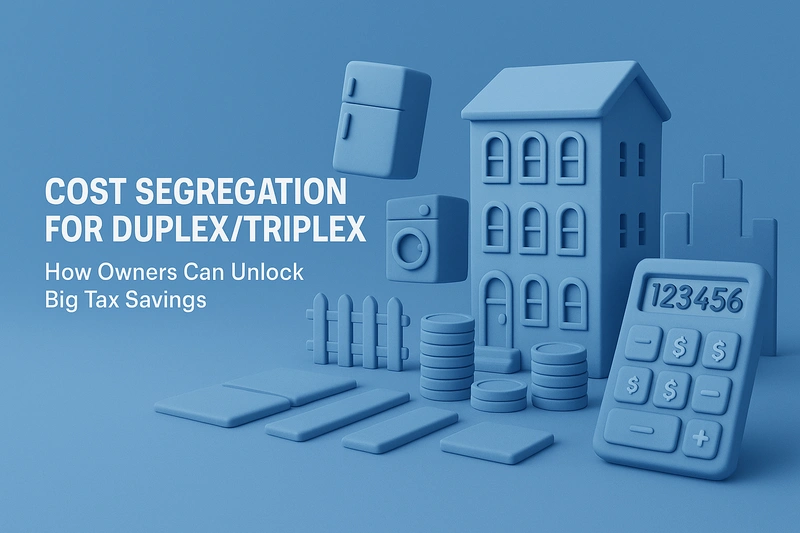Business owners who occupy their commercial properties are sitting on a potential tax goldmine. Most don't realize the dramatic difference cost segregation can make to their bottom line and cash flow. Let us show you the numbers.
Consider this scenario: You're a chiropractor who purchases a $5,000,000 office building (excluding land value). Without cost segregation, you'd typically depreciate about 2.5% of the building's basis in the first year. That's a $100,000 depreciation expense, which is nice. But with a proper cost segregation study, you could potentially depreciate around 20% of the property's basis in year one. That's a staggering $1,000,000 depreciation expense.
At a 24% effective tax rate, this strategy creates $240,000 in additional first-year cash flow. Think of it as an interest-free loan from the IRS that you can reinvest in your property or practice. This isn't small change. It's transformative capital you can put to work immediately.
Strategic Timing for Maximum Benefit
When should you conduct a cost segregation study? The answer depends on your plans for the property. If you're purchasing a building with the intention of performing a gut renovation, wait until the renovation is complete. Just be sure to document the construction process thoroughly with photos and detailed cost tracking.
If you're buying a property to place in service immediately, with only minor renovations planned over time, the optimal moment is right after closing. This timing allows you to benefit from partial asset disposition when you eventually replace components. You'll be able to take additional expense deductions when you remove and replace those assets.
The key is adapting your cost segregation timing to match your business strategy for the property. There's no one-size-fits-all approach here.
Hidden Value in Overlooked Components
The most significant benefits often come from what we call "functional allocation." Your electrical distribution system and plumbing distribution can yield substantial tax advantages when properly classified. If the end terminals are used for business practices, not only those terminals but also the wiring and the percentage of the distribution system that feeds those endpoints can be classified as personal property with five-year depreciation.
Two identical outlets can be classified differently based on their intended use. That's powerful. Removable flooring can also provide notable benefits. Understanding the nuanced distinctions between site improvements and equipment, whether attached to the building or freestanding, can significantly impact your cost segregation study results.
Recent Tax Law Changes and Their Impact
Bonus depreciation has transformed the cost segregation landscape. While it's currently phasing out, it still offers substantial benefits. For property placed in service in 2025, 40% of short-life asset value can be taken in year one, plus the standard depreciation calculation. A $100,000 five-year asset could generate approximately $52,000 in first-year depreciation. Pending legislation in congress may restore 100% bonus deprecation later this year.
Section 179 enhancements have also expanded the classification of qualified improvement property. If you're operating a business and making structural improvements, these can now qualify as 15-year property eligible for bonus depreciation. This creates powerful tax advantages for business owners, improving existing properties.
Selecting the Right Cost Segregation Professional
When evaluating cost segregation providers, prioritize firms that employ engineering expertise. The preferred methodologies involve detailed engineering with either actual or estimated costs. Ask potential providers how they determine national cost averages. They should reference industry standards like Marshall and Swift or RS Means.
Verify that the professionals conducting your study have engineering backgrounds. Ask about their track record. Have they completed hundreds or thousands of studies? Have they worked across various asset classes and geographical regions? Their methodology should explicitly include detailed engineering approaches.
Documentation and Long-Term Strategy
The cornerstone of audit protection is proper documentation that ties back to the basis used in your study. Whether for renovations, acquisitions, or new construction, this connection is your first line of defense. If you're claiming real estate professional status or material participation, tracking those hours is equally important.
Beyond immediate tax benefits, develop an exit strategy. Schedule a call with a R.E. Cost Seg expert to discuss your options. Whether you're planning a 1031 exchange or what some call a "lazy 1031" (buying another property in the same year and cost segregating it to offset recapture expense), thinking ahead is crucial.
Remember that recapture is inevitable. If you bought a property for $1 million, took $500,000 in depreciation, and later sold it for $2 million, you'll need to recapture that depreciation. Even if you didn't take the depreciation you were entitled to, you'll still face recapture based on what you should have taken. A strategic exit plan can protect you from massive recapture expenses.
The immediate benefits of cost segregation are compelling, but the real mastery comes from integrating it into your comprehensive tax and business strategy. When implemented correctly, cost segregation becomes not just a tax strategy but a powerful tool for business growth and wealth creation.






